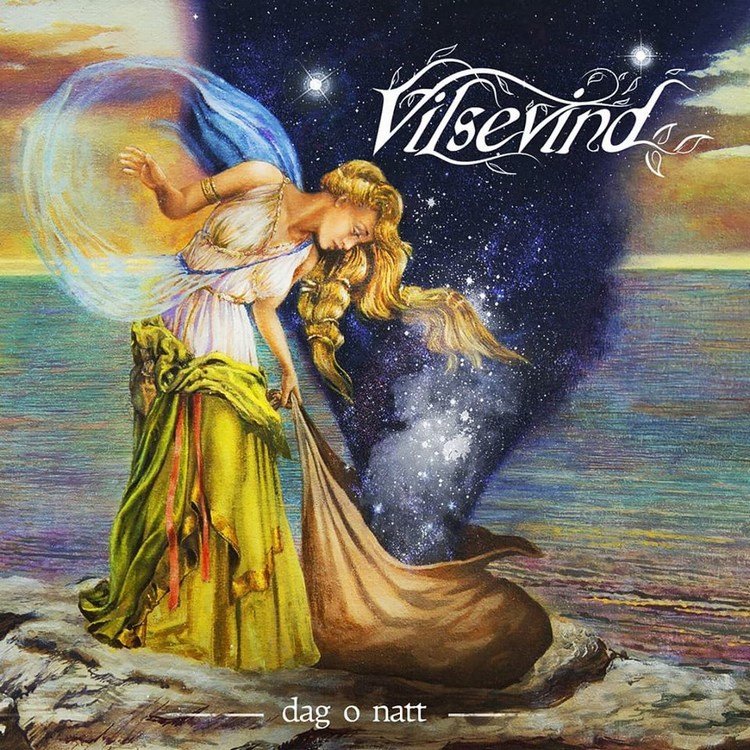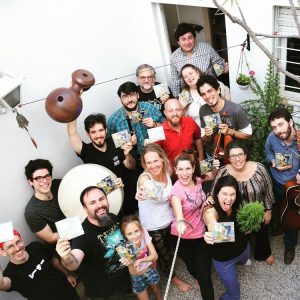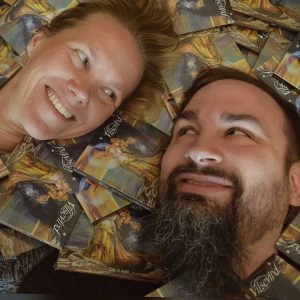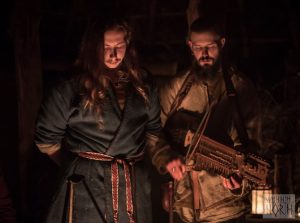You can find Towarb on: Facebook: Towarb Bandcamp: Towarbensemble YouTube: TowarbLast month, we received a message from this band from the Alsace in France. In October, they released their first EP, Unserland, with four beautiful pieces of music. The songs are inspired by regional history and its oldest legends. As soon as you start listening you are in a distant and ancient world. Low voices, dark tones, historical instruments, and primal forces can be felt immediately. This EP is a good start. If you love Sowulo, Heilung, Munknorr and Wardruna it’s a good possibility you like Towarb too. We at CeltCast are looking forward to hearing more of this band! And, maybe on stage in the near future? and My favourite song on Unserland? That is: Sterne. Musical greetings, Ilona CeltCast
Tag Archives: Nordic Folk
Daily Disc Towarb – Unserland (2020)
- 18 Mar
- celtadmin
- 0 Comments
Monthly Marker May 2020: Myrkur
- 05 May
- celtadmin
- 0 Comments

The Power of the Harp
New month, new monthly marker!
Many songs tell us about the magical beauty of harp play and the powers a skilled player can wield under the right circumstances. Previously I was captured myself by Kati Rán’s “Harpa Toner” which upon investigation turned out to be one of many renditions of the same tale that has been traveling throughout Europe, shapeshifting and scope-creeping, evolving in time to well-known versions like Binnorie, The Twa Sisters, The Bonnie Swans and Harp of Death.
Now, once more I am mesmerized by a harp-related song (or should I say ‘sange’? ) and this time as well, I simply had to know what was behind the softly sang lyrics brought across by the tempting voice of none other than Amalie Bruun, a.k.a. Myrkur.
Though mostly known for her Metal albums, Amalie has been diving deeper and deeper into the richness of Scandinavian traditional songs and clearly she came up with some pure Danish gold. As early as January of 2018, some of you may have been lucky enough to witness performances of Myrkur having struck new ground, touring together with other great artists of our scene, like Christopher Juul (Heilung, Euzen) and… you guessed it: Kati Rán. Fortunately her collaboration with Christopher did not end when the tour did. In fact, she stepped into his famous Lava Studios and recently proudly released her latest album Folkesange.
This work of art is a 100% match with our station’s format, which means we will be able to play each individual track and what’s more: we have chosen Harpens Kraft as our new Monthly Marker, meaning we will be playing it 5 to 6 times a day for the month of May!
You can find Myrkur here:
- Website: https://www.myrkurmusic.com/
- Facebook: @myrkurmyrkur
- Instagram: @myrkurmyrkur
- Bandcamp: https://myrkur.bandcamp.com/
Sowulo releases a new album GRIMA
- 02 Apr
- celtadmin
- 0 Comments

Last Monday Sowulo announced that their new album GRIMA will be released coming friday, the 3th of april. according to Faber: “In the last past months I worked on the upcoming Sowulo album. Again I did my best to do something unexpected. I teamed up with Tumulus to create something truly unique.The upcoming GRIMA album contains an immersive combination of Storytelling and Atmospheric music. Tumulus aka Niek van Eck did what he does best: storytelling like a mad skald-wizard, and I had to honour to add some cinematic tune to it. We recorded GRIMA from a place of deep presence, rooted in ancient stories of wisdom.’ The artwork, Faber told us: ‘Consists of drawings by Niek van Eck edited by Jasper van Gheluwe . Friday the 3th of April, American time, GRIMA will be digitally released on all the major platforms and smaller platforms, including Spotify and Sowulo’s Bandcamp page here, where we can all listen the album for the first time. Expect stories of Nordic saga told by Tumulus with compositions by Faber Horbachs hand under it. Indeed something truly unique. The physical album release will take a bit longer. But just might be worth the wait. Of course will keep you informed on that. picture by: Rebeca Franco Valle
Vilsevind – Dag O Natt (2019) Review
- 18 Feb
- celtadmin
- 0 Comments

At CeltCast we don’t often get post from South America. And if that envelope then also includes a Swedish folk CD, you can imagine the music team got a lot more than just interested. We were actually intrigued. The CD we got is called Dag O Natt, and the duo who sent it to us has the typical Argentine name of Vilsevind. A quick look at their Facebook page tells us a bit more: -‘Vilsevind -Swedish for “wandering wind- is a Swedish-Argentine duo made up of spouses Sergio and Johanna Ribnikov Gunnarsson. As sound travels farther on water, their musical style can be described as North Sea music, a crossover between Nordic Folk and Celtic Music. Their main source of inspiration is Nordic history and folk life, superstitions and folklore and nature, especially that of the island of Öland, Johanna’s birthplace.’ And so I ended up with a North Sea folk album all the way from South America on my review desk. And I can already reveal, I am not complaining.So Vilsevind is Swedish-born Johanna Ribnikov Gunnarsson on vocals and concertina, and Argentine-born Sergio Ribnikov Gunnarsson on vocals, Irish bouzouki, guitar, mandolin, hurdy gurdy, jaw harp and offerdalspipa (A Swedish flute based on a flute from the museum of the Offerdal Heritage Centre. It was bequeathed to the Heritage Centre in the 1960s by a man from Fiskviken, a village in the borough of Krokom.) Already an impressive list of instruments.
 But the couple didn’t record Dag O Natt as a pure duo, not at all, it was a huge project with as much as twelve guest musicians involved, playing percussion, guitars, a Galician bagpipe, a Cretan Lyra, Strings and Irish whistles.
Vilsevind themselves already said that they play North Sea music, and from the first notes of Ingång: Dag you can hear this is more than just Swedish folk. This first song actually sounds more like film music with added sound effects. It sounds like a small vessel on the North Sea is washed ashore by the tides of time. In it are two musicians who wake up to tell their tale. I love the cello setting the tone in this song.
Ingång: Dag is followed by the upbeat song Fuego. Fuego is cool mix of folk influences. Think of a mix of the cabaresque sound of
Twigs and Twine,
the Swedish folk of
Asynje
and a touch of medieval bagpipe.
https://www.youtube.com/watch?v=6akBxLpVgpM
The third song, Ödeblues, reminds me even more of Twigs & Twine. Not only in the way the music is arranged -a cabaresque, upbeat ballad that ends up as an acoustic power-ballad- but also in the vocals. Johanna has a pleasant voice that reminds me very much of Lian’s, one of Twigs & Twine’s female vocalists. Sergio has a nice warm voice that complements Johanna’s voice perfectly. As a singing duo their voices work very well together. During Ödeblues the different percussion and Irish bouzouki players join in. Where in Dag you could still say you are listening to a duo, during Fuego and especially Ödeblues it is clear that Vilsevind went for a full band sound. All in all Ingång: Dag, Fuego, and Ödeblues are a very pleasant start to this CD, that up to now is indeed more general Celtic sounding than pure Swedish.
Flat White/Elfshot is an instrumental song that starts as an instrumental Swedish folk ballad with Flat White, with a high pitched string- and tin whistle melody in it, that gives it an ever so slight Japanese/Chinese feel (to my ears at least.) I don’t think it is deliberate, but once I heard it I couldn’t get the comparison out of your mind anymore. What IS intended, is that the song is a lovely Celtic instrumental ballad that suddenly jumps to an Irish up-tempo dance song. And jump is the right word here. It really jumps from a ballad into a cheerful upbeat dance song, including an extremely cool jaw harp rhythm, bound to put a huge smile on your face (As will the story behind this song. Read it, you will laugh your a** off) A lovely musical surprise and this will not be the last surprising twist on Dag O Natt.
Thorsten Fiskare is a nice ballad based on a work by the Ölandic poet and playwright
Erik Johan Stagnelius
.
Most of the songs, written by Sergio, Johanna or both of them together are in Swedish. The only two exceptions are Oración and Kalabalik which are sung in Spanish, the latter by Sergio. As far as I can tell from Google Translate (which had a looooot of trouble trying to translate the Swedish poetic lyrics into proper Dutch) all the songs are island folk poems, telling about universal themes as love, longing, loss, myth, and… wait for it… Coffee! For those who master Spanish, they can read all about the background of the songs on Vilsevind’s webpage. For those non-Spanish speaking readers, try translating the synopsis in Google Translate, that works much better. (Or you can use the link the band provided.
shorturl.at/lmMO5)
Coming back to Thorsten Fiskare, it is definitely one of my favourite songs on Dag O Natt. A lovely ballad to start with, The voices of Johanna and Sergio blend beautifully with the Irish bouzouki, and it would not be a Vilsevind song if the music didn’t change halfway through. In this case, you get the feeling
Trolska Polska
entered the studio to join in for a bit. Totally fitting for the story Vilsevind are telling in Thorsten Fiskare.
Majsol is the loveliest of the ballads on Dag O Natt. A beautiful duet between Irish bouzouki and voice. There are moments at the start where I mistake Sergio’s bouzouki for a harp. Just stunning. The violin and concertina gliding into the sound at the end or the staccato string section after that are just the icing on an already beautiful cake. I have to compliment
Manuel Villar Lifac
on his string arrangements throughout the album, and also
Marcelo Ismael Rodriguez
who recorded, mixed and mastered Dag o Natt to an outstanding quality. I love all the bits and pieces added to the music to make it interesting. Well done!
But the couple didn’t record Dag O Natt as a pure duo, not at all, it was a huge project with as much as twelve guest musicians involved, playing percussion, guitars, a Galician bagpipe, a Cretan Lyra, Strings and Irish whistles.
Vilsevind themselves already said that they play North Sea music, and from the first notes of Ingång: Dag you can hear this is more than just Swedish folk. This first song actually sounds more like film music with added sound effects. It sounds like a small vessel on the North Sea is washed ashore by the tides of time. In it are two musicians who wake up to tell their tale. I love the cello setting the tone in this song.
Ingång: Dag is followed by the upbeat song Fuego. Fuego is cool mix of folk influences. Think of a mix of the cabaresque sound of
Twigs and Twine,
the Swedish folk of
Asynje
and a touch of medieval bagpipe.
https://www.youtube.com/watch?v=6akBxLpVgpM
The third song, Ödeblues, reminds me even more of Twigs & Twine. Not only in the way the music is arranged -a cabaresque, upbeat ballad that ends up as an acoustic power-ballad- but also in the vocals. Johanna has a pleasant voice that reminds me very much of Lian’s, one of Twigs & Twine’s female vocalists. Sergio has a nice warm voice that complements Johanna’s voice perfectly. As a singing duo their voices work very well together. During Ödeblues the different percussion and Irish bouzouki players join in. Where in Dag you could still say you are listening to a duo, during Fuego and especially Ödeblues it is clear that Vilsevind went for a full band sound. All in all Ingång: Dag, Fuego, and Ödeblues are a very pleasant start to this CD, that up to now is indeed more general Celtic sounding than pure Swedish.
Flat White/Elfshot is an instrumental song that starts as an instrumental Swedish folk ballad with Flat White, with a high pitched string- and tin whistle melody in it, that gives it an ever so slight Japanese/Chinese feel (to my ears at least.) I don’t think it is deliberate, but once I heard it I couldn’t get the comparison out of your mind anymore. What IS intended, is that the song is a lovely Celtic instrumental ballad that suddenly jumps to an Irish up-tempo dance song. And jump is the right word here. It really jumps from a ballad into a cheerful upbeat dance song, including an extremely cool jaw harp rhythm, bound to put a huge smile on your face (As will the story behind this song. Read it, you will laugh your a** off) A lovely musical surprise and this will not be the last surprising twist on Dag O Natt.
Thorsten Fiskare is a nice ballad based on a work by the Ölandic poet and playwright
Erik Johan Stagnelius
.
Most of the songs, written by Sergio, Johanna or both of them together are in Swedish. The only two exceptions are Oración and Kalabalik which are sung in Spanish, the latter by Sergio. As far as I can tell from Google Translate (which had a looooot of trouble trying to translate the Swedish poetic lyrics into proper Dutch) all the songs are island folk poems, telling about universal themes as love, longing, loss, myth, and… wait for it… Coffee! For those who master Spanish, they can read all about the background of the songs on Vilsevind’s webpage. For those non-Spanish speaking readers, try translating the synopsis in Google Translate, that works much better. (Or you can use the link the band provided.
shorturl.at/lmMO5)
Coming back to Thorsten Fiskare, it is definitely one of my favourite songs on Dag O Natt. A lovely ballad to start with, The voices of Johanna and Sergio blend beautifully with the Irish bouzouki, and it would not be a Vilsevind song if the music didn’t change halfway through. In this case, you get the feeling
Trolska Polska
entered the studio to join in for a bit. Totally fitting for the story Vilsevind are telling in Thorsten Fiskare.
Majsol is the loveliest of the ballads on Dag O Natt. A beautiful duet between Irish bouzouki and voice. There are moments at the start where I mistake Sergio’s bouzouki for a harp. Just stunning. The violin and concertina gliding into the sound at the end or the staccato string section after that are just the icing on an already beautiful cake. I have to compliment
Manuel Villar Lifac
on his string arrangements throughout the album, and also
Marcelo Ismael Rodriguez
who recorded, mixed and mastered Dag o Natt to an outstanding quality. I love all the bits and pieces added to the music to make it interesting. Well done!
 By now we are nearing the end of the album. Virvelsinn is the song the duo wrote to give the name Vilsevind and everything it stands for its own voice. And indeed it represents the band perfectly. Virvelsinn is a celebration of poetic, European folk music. It feels like Johanna has taken the memories of her musical heritage and, together with the love of her life, and the new friends she gained, she plays it in a new land, both to cherish those memories and to give the music as a gift to the people in a new land she clearly loves too.
Kalabalik is one of the two songs in Spanish and the only one with Sergio on lead vocals, but don’t expect it to sound Argentinian at all. It’s a wonderful blend of Irish folk and Swedish traditional music in the Spanish tongue, admittedly with a bit of accordion that takes me to the lovely Celtic folk made in Brittany, as
Wouter & de Draak
would play it. And in that way Vilsevind keeps mixing the best bits of the western European folk music together. And Vilsevind has yet more tricks up their sleeve, how about an Indian sitar blended into Swedish folk for instance? In Vilsevinds musical world, not a problem. Another example is the lovely folk-pop flute melody in Tusentals Färdas, a song that could easily have been on
Gwendolyn Snowdon’s
latest solo album too.
And that sums up Vilsevinds music. Its positive happy music, made with a big wink and a huge smile. Dag o Natt is indeed what Sergio and Johanna claim it is on their website: “A celebration of Swedish and Celtic folk music combined.” A celebration that I hope to hear a lot more of in the future. The world can use more musical smiles like this. A lot more, actually!
– Cliff
Editor: Sara Weeda,
Sleeve art: Sandra Núnez Castro,
Pictures: Vilsevind
By now we are nearing the end of the album. Virvelsinn is the song the duo wrote to give the name Vilsevind and everything it stands for its own voice. And indeed it represents the band perfectly. Virvelsinn is a celebration of poetic, European folk music. It feels like Johanna has taken the memories of her musical heritage and, together with the love of her life, and the new friends she gained, she plays it in a new land, both to cherish those memories and to give the music as a gift to the people in a new land she clearly loves too.
Kalabalik is one of the two songs in Spanish and the only one with Sergio on lead vocals, but don’t expect it to sound Argentinian at all. It’s a wonderful blend of Irish folk and Swedish traditional music in the Spanish tongue, admittedly with a bit of accordion that takes me to the lovely Celtic folk made in Brittany, as
Wouter & de Draak
would play it. And in that way Vilsevind keeps mixing the best bits of the western European folk music together. And Vilsevind has yet more tricks up their sleeve, how about an Indian sitar blended into Swedish folk for instance? In Vilsevinds musical world, not a problem. Another example is the lovely folk-pop flute melody in Tusentals Färdas, a song that could easily have been on
Gwendolyn Snowdon’s
latest solo album too.
And that sums up Vilsevinds music. Its positive happy music, made with a big wink and a huge smile. Dag o Natt is indeed what Sergio and Johanna claim it is on their website: “A celebration of Swedish and Celtic folk music combined.” A celebration that I hope to hear a lot more of in the future. The world can use more musical smiles like this. A lot more, actually!
– Cliff
Editor: Sara Weeda,
Sleeve art: Sandra Núnez Castro,
Pictures: Vilsevind



